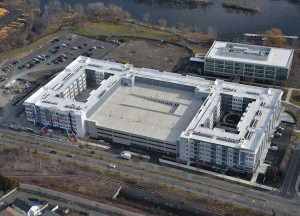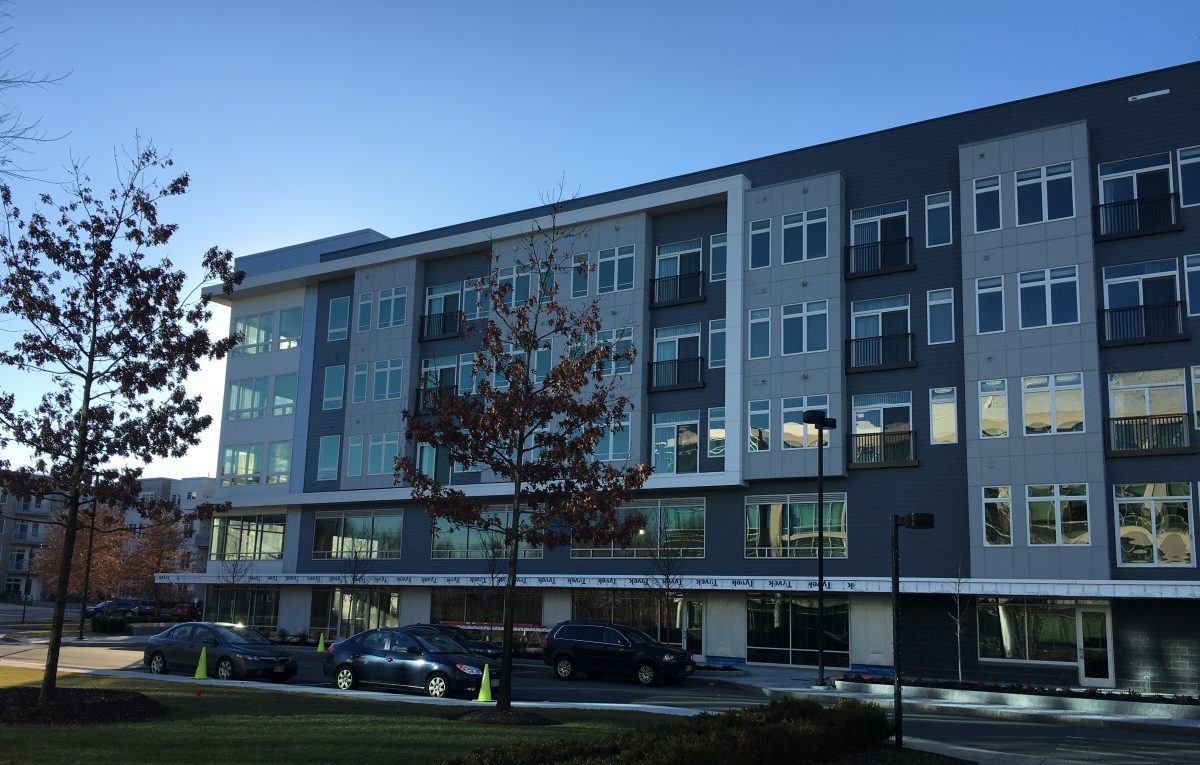Geopier Rigid Inclusion and Rammed Aggregate Pier Systems Prove To Be The Fastest And Most Cost-Efficient Ground Improvement Solution
Introduction:
The Residences at River’s Edge project was a five-story mixed-use building constructed in Medford, MA. The development featured 282 units, a four-story, 1,042-space parking garage and ample retail space on the ground level.
Geotechnical Challenges:
The project site’s soil conditions consisted of up to 15 feet of granular fill, underlain by up to 12 feet of soft organic soils and 2 to 12 feet of medium-dense fluvial sand deposits. A thick deposit of marine clay was encountered beneath the sand deposits. The marine clay had a stiff, upper desiccated “crust” and became soft with depth, which is common in the Boston area. The soft marine clay was generally about 60-feet-thick and underlain by dense glacial till and bedrock. Groundwater was encountered at about 5 feet below grade.
Geotechnical Design Solution:
 The design team evaluated several foundation support solutions including pressure injected footings (PIFs) and belled drilled shafts extending down into the fluvial sand layer, as well as deep driven end-bearing piles terminating in the glacial till layer/bedrock. These traditional solutions all required pile caps and grade beams. Geopier GeoConcrete® (GCC) Column rigid inclusion and Impact® Rammed Aggregate Pier® (RAP) elements allowed for traditional shallow footings and slab-on-grade construction. The GCC/RAP ground improvement system proved to be the fastest and most cost-efficient solution.
The design team evaluated several foundation support solutions including pressure injected footings (PIFs) and belled drilled shafts extending down into the fluvial sand layer, as well as deep driven end-bearing piles terminating in the glacial till layer/bedrock. These traditional solutions all required pile caps and grade beams. Geopier GeoConcrete® (GCC) Column rigid inclusion and Impact® Rammed Aggregate Pier® (RAP) elements allowed for traditional shallow footings and slab-on-grade construction. The GCC/RAP ground improvement system proved to be the fastest and most cost-efficient solution.
The system provided a maximum allowable footing bearing pressure of 6 kips per square foot (ksf) and was designed to limit total and differential post-construction footing settlement to less than 1-inch and ½-inch respectively.
Ground Improvement Construction:
Helical installed more than 2,000 GeoConcrete Column rigid inclusion and 500 Rammed Aggregate Pier elements over a 40-day period. The RAP elements were installed to provide floor slab support in limited areas, while column and wall footings were supported by GCC rigid inclusion elements. The elements extended through the unsuitable fill and organics and terminated in the underlying medium dense fluvial sand or stiff clay crust. The GCC design included a structural fill pad (“footing pad”) located beneath the footings to help transfer stresses to the GCCs and surrounding matrix soil and also provided a stable subgrade for footing construction. The majority of Geopier RAP and GCC elements were installed using a displacement mandrel, which helped minimize the generation of environmentally-impacted spoils and reduce associated site premiums. In certain areas of the site, extremely dense fill with thick layers of crushed concrete was encountered. In these areas, the upper 5 to 10 feet of fill was pre-augered to loosen the fill prior to advancing the displacement mandrel into the ground.
Quality Assurance and Control:
Helical’s crew included a full-time Quality Control person to oversee all testing and installation procedures. Full-scale field modulus testing performed to 200% of the GCC element design stress confirmed the GCC design stiffness and showed element deflections of less than about ¼-inch at the design stress.
Geopier Ground Improvement Advantages:
- Allowed for conventional shallow footing construction rather than PIFs or driven piles with pile caps, and grade beams
- Displacement construction method minimized the generation of environmentally-impacted spoils
- Substantial cost savings
- Quick installation helped expedite an aggressive construction schedule

